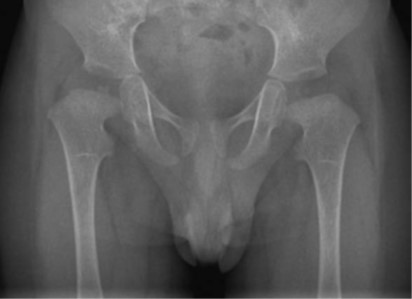see also spondylo-epi-metaphyseal dysplasias
(Rolland-Desbuquois dyssegmentar dysplasia )
[MIM 251 450, 300 881, 615 777]
Autosomal recessive transmission. There are:
- type 1: mutations of the CANT1 gene (17q25.3). The clinical character of it is the presence of an accessory ossification nucleus at the level of the second metacarpal, of distal bifid phalanges or of a thumb with a delta-shaped phalanx
- type 2: mutations of the XYLT1 gene (16p12) coding for xylosyltransferase (synthesis of the proteoglycans)
- Kim type 1 variant, described in Japan and Korea: short stature, few facial anomalies, and anomalies of the hands (short metacarpals, elongated phalanges, advanced osseous age)
Severe micromelic dwarfism due to segmental abnormalities of the vertebrae (platyspondyly, split vertebrae), especially the cervical ones with limitation of the extension of the neck.
In addition:
- short and curved limbs
- facial dysmorphism: round facies, protruding eyes, midface hypoplasia, short nose, microstomia, microretrognathism and cleft palate (often Pierre Robin triad)
- thoracic hypoplasia, cyphoscoliosis,
- laxity of the joints
- osteopenia; XRays: 'monkey wrench' appearance of the proximal femur

Sometimes: glaucoma, congenital heart disease (ASD or VSD), pulmonary hypoplasia, club feet (sometimes rocker bottom feet).
In type 1, death in infancy from pulmonary complications.
Prenatal diagnosis: hydramnios, fetal hydrops, growth retardation, vertebral anomalies.
Anesthetic implications:
short stature: careful choice of the diameter of the ETT (preoperative US measurement ?) and risk of bronchial intubation; facial dysmorphism (midface hypoplasia/or micrognathism): risk of difficult intubation because of small mouth, retrognathism, limition of the neck extension: the use of a laryngeal mask may be ineffective; possible mental retardation; poor ventilatory function
References:
- Szmuk P, Matuszceak M, Carlson RF, Warters RD, Rabb MF, Ezri T.
Use of a CobraPLA for airway management in a neonate with Desbuquois syndrome. Case report and anesthetic implications.
Pediatr Anesth 2005; 15: 602-5.
- Okutani T, Arima Y, Oda Y.
Anesthetic management in a child with Rolland-Desbuquois type dyssegmental dysplasia.
J Clin Anesth 2014; 26 : 676-8
- Menziesa L, Cullupc T, Calderb A, Wilsona L, Faravelli F.
A novel homozygous variant in CANT1 in a patient with Kim-type Desbuquois dysplasia.
Clinical Dysmorphology 2019 ; 28:219-23
Updated: November 2023